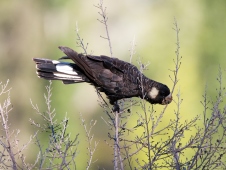
BirdLife Australia’s work to conserve Carnaby’s Black-cockatoo involves community engagement and education along with supporting private landholders to preserve and restore habitat. Since 2004 a volunteer team has repaired over 150 damaged or degraded nesting trees, a simple and inexpensive way to increase the chances of breeding.
Carnaby’s Black-Cockatoo Calyptorhynchus latirostris has a large distribution covering many different vegetation types in south-west Australia. With support from the Australian Government, BirdLife Australia has been working with local communities, landholders and land managers to secure the protection and conservation of the species and its habitat. This has involved community engagement programs and education, along with provision of support to private landholders to preserve and restore priority remnant vegetation types.
Baseline data-collection and nest-monitoring are being implemented. Since 2004, a volunteer team has repaired over 150 damaged or degraded nesting trees, a simple and inexpensive way to increase the chances of breeding.
Related Species
Compiled: 2013 Copyright: 2013
Recommended Citation:
BirdLife International (2013)
Habitats for Carnaby’s Black-cockatoo are being restored through work with private landowners.
Downloaded from https://datazone.birdlife.org/habitats-for-carnaby’s-black-cockatoo-are-being-restored-through-work-with-private-landowners on 22/12/2024